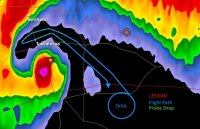Mike Benefield
EF1
Balloon right into the inflow would be the mode. Smaller balloon with a reasonable light payload and some balancing via gyros, etc would deliver cameras and a radiosonde into an area of rotation. How long that balloon would survive for the instruments to do any good is questionable but the images derived from such a flight opportunity would be amazing I'd imagine.
I've considered a UAV and actually have a DJI Phantom 2+ that could act as a sacrificial lamb since I've recently upgraded. With my luck though, the silly thing would fall out of the sky or become a projectile and hurt someone.
Is your goal to take advantage of the updraft in the meso/tornado to gain altitude in order to measure the updraft wind speeds or other data? If you want to take measurements as the radiosonde drops, what type of data are you seeking to measure? In my project, I want to obtain measurements in the updraft at the lowest levels of the tornado. There have been many studies of at the mid- and upper levels of the storm. I want to see what's going on in the 0-2.5 km range. I really want to analyze a multiple vortex tornado. I've never considered taking measurements as the device drops through the storm, but I am intrigued by what data might be obtained by doing so.

